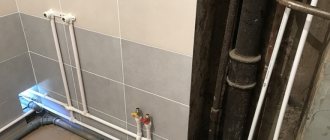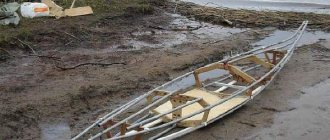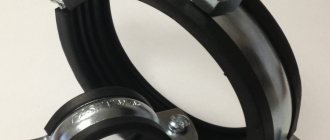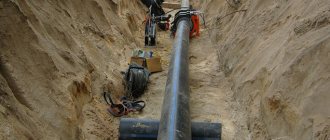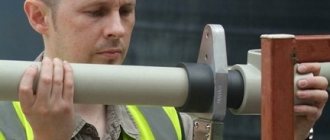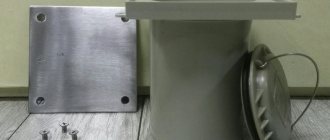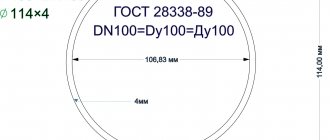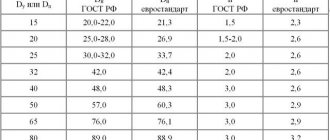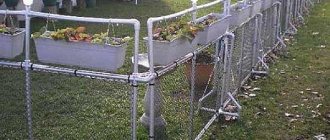A fence made from a profile pipe is fast, reliable and beautiful. Affordable price and low labor costs during installation have made this fencing popular among all segments of the population. Using decorative elements, you can give the fence an elegant, aesthetic appearance. Find out which option to choose and how to decorate by reading the article.
A fence made from a profile tube can be a compromise between overly expensive and very budget options for fencing a suburban area
Fences made of profile pipes in landscape design
When choosing a material for a fence from a profiled pipe, know that it will meet all the criteria - it will thoroughly protect the site, will last a long time, and will beautifully complement the landscape design. Its wooden or brick counterparts are much more expensive, require more construction and maintenance, and do not withstand bad weather.
A fence based on a profile pipe is strong, reliable and durable
A simple fence will serve to fence only a house under construction, a plot of land for agricultural work, or sports grounds. A more serious structure is suitable for a summer residence, while beautifully decorated ones will complement the overall picture of luxurious cottages and mansions.
Fencing made from profile pipes can be easily decorated with decorative elements
In terms of price-quality ratio, steel structures made from corrugated pipes outperform other materials. They are often used in combination with corrugated sheets, plastic, metal picket fences, and are sewn up with chain-link mesh. For decoration, figured elements of decorative forging are used, they are landscaped with hedges, and painted.
Profiled pipes are the main component in all structures; their rectangular and square shapes have long replaced round pipes. They are much easier to work with, a more reliable bond is formed during welding, and they have a large selection of sections.
Hedge
The most spectacular type of front garden fencing.
For these purposes you can use:
- Evergreen flowering shrubs (medium height hedge): holly, strawberry tree, boxwood, heather, euonymus, barberry and other species.
- High fences: thuja, spruce, pine.
- Long flowering shrubs: buddleia, spray rose, garden jasmine and other flowering bush plants.
Depending on the style of the site and preferences, you can leave the bushes in their natural form. To design areas in regulatory styles, with clear geometric shapes, shrubs are trimmed. In this context, privet, boxwood, and holly will look good.
A hedge can act as an independent fence, or in combination with a permanently installed fence.
Coniferous shrubs for hedges around the front garden Source ap.dnsfor.me
Advantages and disadvantages of using corrugated pipe as a fencing material
Having some experience with a welding machine and making welded metal structures yourself, you can save a lot. Such hedges have a number of distinctive features compared to others.
An impressive list of advantages of fences made of profile pipes makes them very popular among garden owners
Advantages of profile fences:
- Reliability – with proper installation, they perform 100% protective functions, protecting against the penetration of strangers and animals.
- The opportunity to order or build a structure yourself according to your own drawing, corresponding to the budget, for any landscape design.
- Long service life, subject to high-quality performance and care, a total of 50 years.
- Easy installation.
- Low cost, except for expensive projects that include a lot of expensive decor.
- Complete fire safety.
- The transmission capacity of the sun and air masses is favorable for the growth of garden and vegetable crops, which is very important for people involved in plant growing.
These are not all the advantages; a fence made of a square pipe tolerates temperature changes and bad weather well. It is practical - it is used as the main fence, for zoning the territory, and is easily installed on a surface with uneven terrain.
The photo shows an example of a fence made of profile pipes on an area with relief
Minuses:
- It is advisable not to carry out welding work in the heat, this is a fire hazard.
- It is not recommended to touch fence elements heated by the sun; they become very hot and can cause burns.
- There is no protection from wind and dust, although combined fencing fully guarantees it.
Despite the listed disadvantages, which are better called features, fences made of profile pipes are in great demand. They are located not only on individual plots, but also on children's and sports grounds, parking lots, industrial enterprises, and city parks.
For private construction, two types of pipes are used. The first is metal profiled products with a cross section of 30×30, with a wall thickness of up to 1 mm, for filling the spans. The second is a corrugated pipe with a cut of 110×110, wall size up to 5 mm, used as a support.
How to prepare
Preparation for the construction of a metal fence begins with the development of a drawing of the future structure, the acquisition of the necessary materials and tools.
Required Tools
- Welding machine with a set of electrodes.
- Grinder with discs for cutting and grinding metal.
- Screwdriver or screwdriver.
- Yardstick.
- Building level.
- Drill or shovel.
The following additional components will be required:
- Hinges for wickets and gates.
- Door handles.
- Gate lock.
- Latches or bolts for gates.
Preparation of the drawing
Do you need a fence sketch? Undoubtedly! A schematic representation of the future structure will allow:
- develop a model adapted to the individual characteristics of the site;
- accurately calculate the required quantity and type of material;
As a basis, you can take one of your favorite sketches posted freely on the Internet.
It is not necessary to make a drawing of the entire fence, just make a sketch:
- one section, duplicated in the remaining spans;
- extreme modules, if they differ in the set of elements from the main spans;
- models of wickets and gates, taking into account the adjacent power support pillars;
- installation of decorative elements:
The sketch must necessarily reflect:
- dimensions of the fence structure as a whole and its individual parts in particular;
- description of the required materials (size, cross-section, etc.);
- depth of the foundation and supporting pillars:
Selecting the dimensions and section of the profile
Industrially produced pipes have different sizes. The table shows the nomenclatures used in the production of metal fences:
| Section, mm | Wall thickness, mm | Application |
| 10×10 | 1,5 — 2 | Decorative filling of the inter-column space. Strengthening the rigidity of the structure as a whole. |
| 25×25 | 3 | The so-called logs that fasten the metal structure horizontally. |
| 30×30 | ||
| 40×40 | 3 | Non-load-bearing vertical posts of the structure. |
| 50×50 | ||
| 100×100 | 5 — 8 | Main supporting elements (pillars). |
| 200×200 |
It is important that load-bearing elements provide a sufficient margin of safety, and decorative elements do not create excessive load.
Design options
The main advantage of this rolled metal product is that by making a frame out of it or just installing support pipes, you can experiment and combine it with other materials.
Combining various materials allows you to find very interesting solutions for fencing a suburban area
Fences combined with polycarbonate or plastic
An unusual, non-standard solution to use polycarbonate (translucent plastic) as the main fabric. There are two types of polymer:
- Monolithic - in the form of sheets with a thickness of 4-12 mm.
- Honeycomb - two plates are connected by stiffening ribs and form a single whole, reminiscent of a honeycomb. Thickness reaches 32 mm.
It is very light, 16 times lighter than glass, which greatly facilitates installation and transportation. It does not crack or chip, resists strong gusts of wind, and can withstand temperatures around +120 degrees. Polycarbonate can be confidently called a new generation material.
A simple fence made of polycarbonate, fixed to veins from a profile pipe
Beautiful combination of polycarbonate with a frame made of profile pipes
PVC panels can have different designs:
- lattice;
- wicker;
- typesetting in the form of a picket fence;
- with blind sections.
They are easy to install and do not require special care. Owners most often prefer white plastic panels; it does not fade like colored ones, and it looks elegant in combination with the white walls of the house.
White fence made of PVC panels
A large selection of colors and shades will allow you to successfully combine polycarbonate and plastic with metal supports, and artistic forging details will highlight the delicate taste of the owners.
Fence made of pipes in combination with profiled sheets
A variety of corrugated sheets, providing protection from noise, dust, and the views of annoying neighbors are just a small list of the main qualities and functions that this structure performs. This is a simple, but very reliable and inexpensive solution that can be made into a highlight surrounding the garden area. It is enough to paint it in graffiti style or depict a picture, make the upper edges of the corrugated sheet shaped, add forging elements or parts cut from thin steel. Evergreen shrubs and dwarf trees planted in front of it will also decorate and enliven the strict structure.
Fence made of corrugated sheets on metal posts
Fence made of corrugated sheets on brick pillars
Fence made of corrugated sheets in a frame of profile pipes
Profile fences in combination with professional pipes are the most common option. Due to their availability, long service life and reliability, they are used in summer cottages and used to fence country houses and cottages.
Use with metal picket fence
Previously, the picket fence was made of only one material - an ordinary board. The new idea of using metal instead of wood became widespread, first recognized in Europe, and then both domestic craftsmen and owners appreciated it.
A simple fence made of a metal picket fence mounted on a profile pipe
Metal picket fence is a shaped metal strip with stiffening ribs and holes for mounting on a frame made of corrugated pipes, galvanized and coated with polymers. The owner decides how transparent or closed the fence will be, leaving more or less distance between the spans. The Euro picket fence ventilates the area well, does not completely shade, looks presentable, it is not for nothing that Germany and Belgium are the leaders in its production.
Closed fence with staggered picket fence
There are several varieties:
- anti-vandal profile;
- shaped appearance;
- under the tree.
By alternating planks of different lengths, you can get all sorts of shapes of sections; the picket fence will not need any additional decorations.
Welded fences
This type includes fences welded using round metal rods. The basis for them is a frame made of corrugated pipes, onto which rods are welded. Although these designs are simple and are considered suitable only as temporary fencing, they can be transformed with details that curve with wavy lines along the top of the section.
A fairly simple version of a fence consisting of vertical elements
Due to the large distance between the rods, you cannot hide behind it from prying eyes, but it is possible to limit access for people and animals by making a small interval between them and using protruding flattened tips.
Welded fence made of profile pipes on a brick base
Forged elements welded to the round profile will create a unique pattern that will become the calling card of a country residence or a chic restaurant. The tops decorated with beautiful peaks and tips will not only have decorative value, but will also become a significant barrier to entry into private property.
Welded fences from rods are made according to drawings, this makes it easier to calculate the amount of material needed and determine the amount of work.
Fence
A fence made of wooden slats, a picket fence, is a familiar and popular type of fencing.
Among the advantages of the fence:
- harmonizes with the natural landscapes of the site;
- can be combined with other materials, for example, wild stone, forging;
- fast, easy installation;
- variety of forms.
A picket fence for a front garden is used mainly for fencing flower beds, flower beds, and selecting certain zones on the site.
Picket fence shapes:
- Ordinary (ordinary). Straight planks installed with or without gaps.
- Peak. The upper end has cut corners (picket fence) or in the form of a diamond (peak).
- Wavy (including concave). The slats are selected in height so that they imitate a wave.
- The cut edges of the top bar are called “cat or dog ears.”
- Crown. The upper cut resembles an element of the crown of a crown.
A metal picket fence will help you save on fencing Source vorotavtomske.ru
A picket fence installed in the shape of a fan looks interesting. For expressiveness, the planks are painted in different colors. It will be correct if they are in harmony with the color palette of the facade of the house. A fence made of planks covered with varnish looks natural; the beautiful texture of the wood is visible through it.
Only well-dried wood is suitable for making a picket fence, otherwise the planks may fail. It is necessary to treat the wood with protective agents.
Horizontal picket fence Source yandex.uz
Install the fence on wooden supports. The cross bars are attached to the support posts using nails, wood screws, and metal corners. The dimensions of the supporting structures are selected in proportion to the size of the picket fence, based on the load on the pillars.
Tall wooden picket fence Source washzabor.ru
The picket fence looks beautiful and harmonizes with flowering plants.
Sketches and photos of examples of finished fences
We present photographs of fences made of corrugated pipe in combination with other materials.
Sketch of an intake section made from a profile pipe
A sketch is a prerequisite for creating an estimate and successfully completing the work.
This is what a section of a simple fence looks like at the initial stage of welding:
Welding fence elements
An ordinary high green fence harmonizes well with the emerald lawn.
Green fence made of square pipe
An elegant, painted fence made of corrugated sheets mounted on profiled pipes fits well into the picturesque surrounding nature.
Painting on a fence can visually expand the boundaries of a garden plot
A fence decorated with pointed tips on rods of different lengths is not only reliable protection, but also a noble appearance.
A simple fence made from a profile pipe with peaks
A chic fence combined with forging elements and polycarbonate, mounted on profile pipes.
Combined fence with brick pillars and base
The wide range of uses of fences made of profiled pipes has made them universal. They are used to enclose small summer cottages or huge agricultural areas, combined with cheap and expensive building materials, and decorated to suit any landscape design. Having correctly assembled and installed the fence, rest assured, it will last a long time and protect the owners from uninvited guests.
Preparatory work
First of all, you need to prepare the gate, gate and the fence frame itself. To do this, the galvanized pipe is cut to the required dimensions. Step-by-step instruction:
- First you need to create a drawing and cut profile pipes for the vertical rails of the fence. In this case, all parts must be made exactly to size. When working with an angle grinder, you should follow safety precautions.
- The corrugated pipe for vertical supports should be sawed taking into account which fastening scheme is chosen for the installation of the underground part. For reliable fastening, the future frame is deepened into the ground by 1/3. So, to the required height of the corrugated board fencing you need to add the appropriate size.
- The pitch of the horizontal joists will depend on the distance of the installed supports.
A drawing of the fence section is presented below.
The smaller the distance between the support pillars, the more reliable the fastening of pipes in spans will be.
Photos of finished fences made of profile pipes
Price
As for the price, in this case the most important thing is to take into account the material of the canvas. For example, the price of a fence made of corrugated pipes 2 m high per linear meter is about 4,500 rubles. This cost includes installation of poles, filling of spans and painting. The most common price ranges are:
- The cost of the simplest option is approximately 3,000 rubles. per 1 linear meter.
- Average level - about 4400 rubles. per 1 linear meter.
- Business class – 5800 rub. and above per 1 linear meter.
In any case, the price of the fence will depend on its components. Since sometimes the supports are made of concrete or brick, this significantly affects the final cost.
As practice has shown, if you choose the right profile pipes and follow all installation technologies during installation, you can get an original and practical fence. And positive reviews and visual photos are a clear example of this.
Source
Painting
Painting can be done in a professional spray booth or using powder coating technology.
It is possible to add decorative forged elements, as well as antique painting using blacksmith paints and patina of the WS Patina brand, in particular the colors “gold”, “copper”, “bronze”, “greenery”, “silver”, “violet”.
To provide the necessary long-term protection of the metal from corrosion, the surface of the welded section is covered with a protective coating. We provide painting services:
- Anti-corrosion enamel PF, which is based on pentaphthalic varnish;
- "Tikkurila";
- "Hammerite";
- HF enamel, which is based on perchlorovinyl varnish, which is often used in painting building facades;
- Forge paint WS-Plast, in which you can use different color variations.
To protect metal from corrosion for a longer period of time, we use cold galvanizing with Zinga primer.
Painting price
| Paintwork | Price in rub/m2 |
| Soil GF-021 | 175 |
| GF primer + HB enamel (basic colors: black, grey, brown, white) | 325 |
| GF primer + tinted Tikkuril enamel | 525 |
| WS-Plast primer + WS-Plast enamel (base colors) | 725 |
| Patination WS-Patina (base colors) | 325 |


